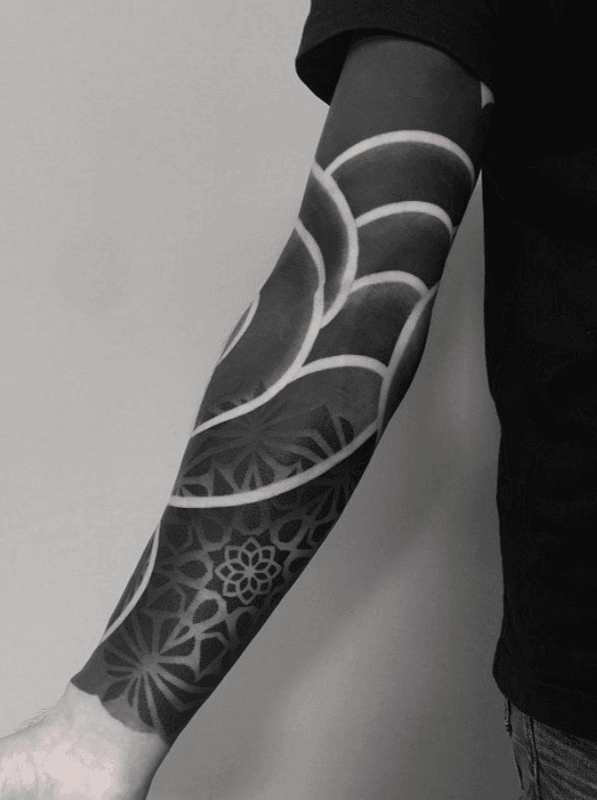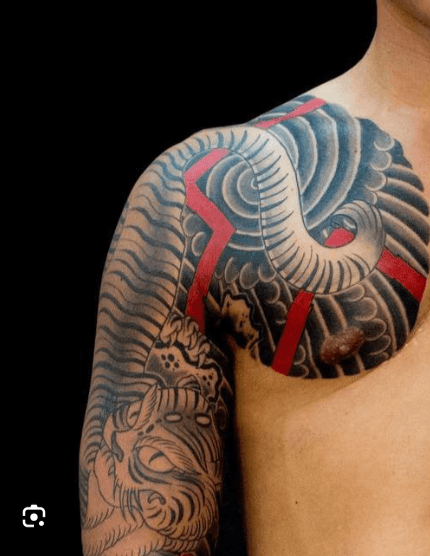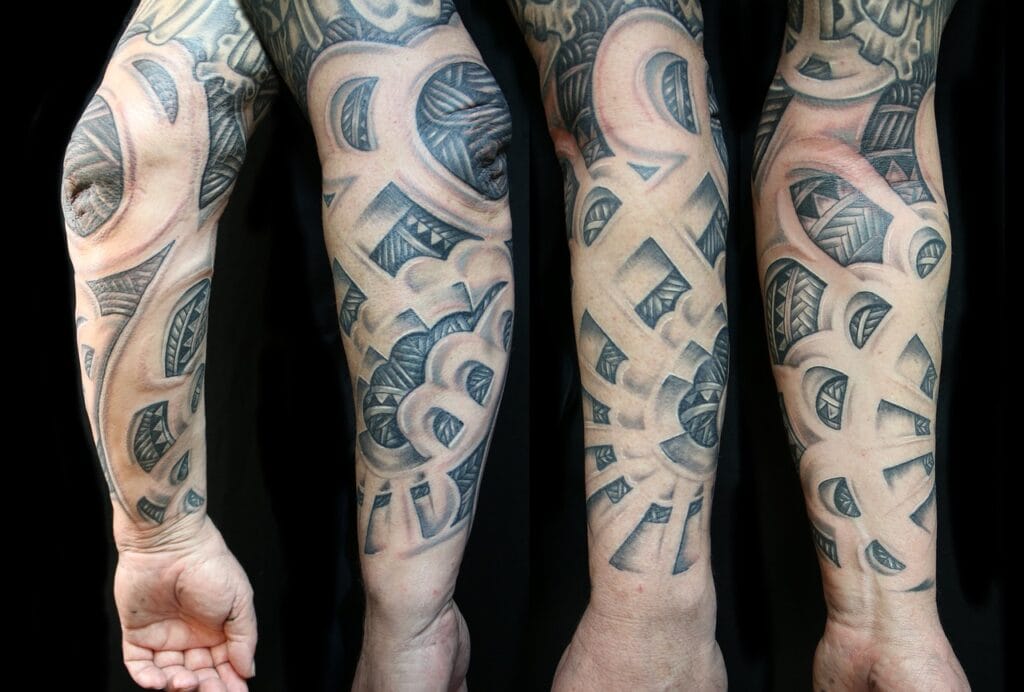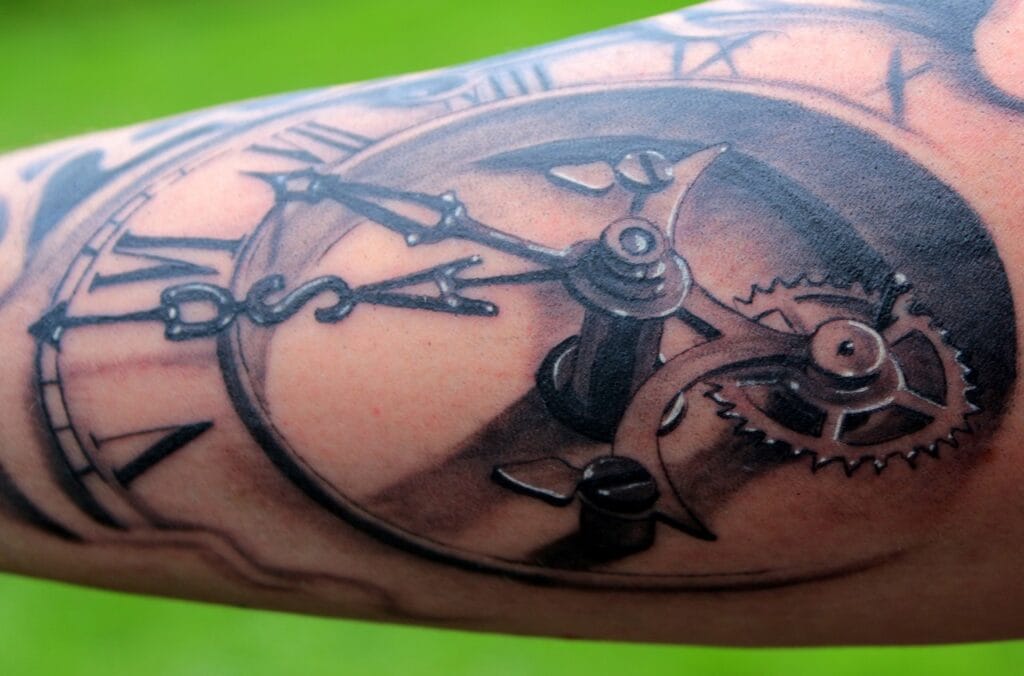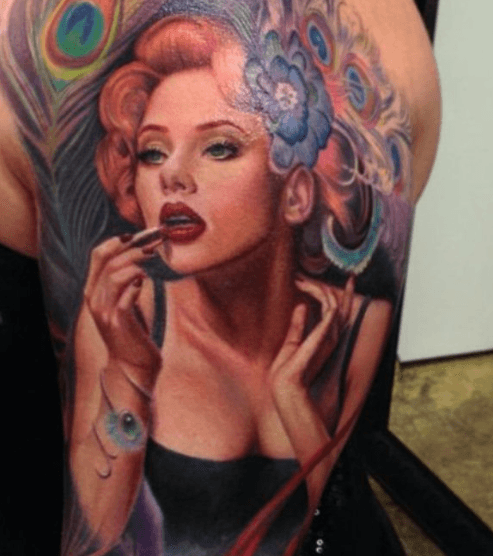When it comes to sleeve tattoo ideas for men on Arm, the designs often focus on themes of strength, heritage, and individualism, with a bold artistic flair. Men’s tattoos typically convey a sense of personal power, honor, or philosophical depth. Tribal patterns, for example, have long been favored for their rich cultural history and powerful visuals, while animal motifs like lions, eagles, or wolves symbolize dominance, freedom, and resilience.
Popular styles like traditional Japanese tattoos (Irezumi) or American traditional (old school) are known for their bold lines, strong color contrasts, and intricate details, offering a lasting impact. Blackwork, a minimalistic and visually striking style, has also grown in popularity due to its sharp contrasts and deep symbolism, often seen in large-scale, abstract pieces or geometric designs.
When choosing placement, the upper arms, chest, and back are common areas for men’s tattoos, as they provide ample space for large, detailed artwork. These areas also allow for extensive coverage, making them ideal for bold patterns and intricate designs that can span across muscle groups, enhancing the overall visual effect.
Beyond aesthetics, men’s tattoos often serve as a tribute to personal or cultural stories. Designs might feature family crests, ancient warrior symbols, or detailed nature scenes, tailored to reflect individual accomplishments or beliefs. Whether it’s a sleeve filled with symbols of personal milestones or a more abstract piece that celebrates philosophical ideals, tattoo ideas for men on arm are as much about self-expression as they are about art.
1. Tribal Sleeve Tattoos
Tribal tattoos have been around for centuries, but they never go out of style. These patterns are bold, using thick, black lines to form intricate, repetitive designs. Tribes from around the world have their own unique patterns, such as the Maori, Polynesian, and Samoan designs. Each of these patterns has cultural significance, often symbolizing strength, protection, or heritage.
“The intricacy and history behind tribal tattoos make them a powerful statement,” says tattoo artist Josh Woods. “Each line and shape has meaning.” So, if you’re interested in getting ink that connects you to ancient traditions, a tribal tattoo might be the perfect choice.
2. Japanese Irezumi
Japanese Irezumi, the traditional Japanese tattooing style, carries a rich history dating back centuries. Known for its stunningly detailed imagery, Irezumi often covers large portions of the body, making it a prime choice for those considering tattoo ideas for men on arm. The imagery isn’t just for aesthetic purposes; every symbol holds deep cultural significance. Popular elements like dragons, koi fish, and tigers are believed to represent virtues such as strength, perseverance, and bravery, which are perfect themes for arm tattoos.
A hallmark of Irezumi is its use of vivid colors, intricate shading, and bold lines, often intertwined with background elements like waves, clouds, and cherry blossoms. “In Irezumi, the flow of water or wind depicted through clouds and waves guides the movement of the tattoo across the body,” explains Takashi Hiroshi, a respected tattoo artist specializing in this ancient art form. “It’s about creating harmony and balance, while also embedding meaning into every element.”
Dragons, a staple in Irezumi, are seen as protectors, symbolizing wisdom and strength. Koi fish, often swimming upstream, represent perseverance and overcoming life’s challenges, making them a popular choice for tattoo patterns for men who want to tell a story of resilience. Meanwhile, tigers signify courage and ward off evil spirits, adding a layer of mysticism to the design.
What makes Japanese Irezumi truly unique is its cultural depth. The placement of tattoos in Irezumi is deliberate and carefully considered, particularly for those exploring tattoo ideas for men on arm. Traditional full sleeves often start at the shoulder and extend down to the wrist, but they can be designed to complement other body parts like the chest and back, creating a flowing, cohesive body suit over time.
While modern tattoo machines are often used today, traditional Irezumi was done by hand, using a method called tebori. This painstaking technique involves inserting ink into the skin manually, and although it’s less common now, some tattoo artists still practice it for its authentic finish. This gives depth to the experience, especially for those seeking tattoo ideas for men on arm that reflect cultural respect and artistry.
For anyone considering Irezumi for their sleeve tattoo, it’s not just a matter of style—it’s about embracing a centuries-old tradition, where every stroke of ink tells a story. As Hiroshi notes, “Irezumi is not merely body art; it’s a living narrative, worn on the skin and carried throughout life.”
This blend of personal storytelling, cultural respect, and intricate artistry makes Irezumi a compelling choice for tattoo enthusiasts looking for more than just a visual statement. It offers a connection to something larger, blending the wearer’s journey with a rich artistic heritage.
“Irezumi is not just a tattoo—it’s an art form,” says Takashi Hiroshi, a well-known Japanese tattoo artist. “Every element has its own meaning, from protection to prosperity.” This style is perfect for someone who wants to blend artistry with a deep cultural connection.
3. Geometric Patterns
For the mathematically inclined (or anyone who likes symmetry), geometric tattoo patterns for men are a fantastic option, especially when considering tattoo ideas for men on arm. These designs focus on shapes, lines, and patterns that create a visually striking and harmonious composition. From simple shapes like triangles to complex mandalas, geometric sleeve tattoos are modern and unique.
Geometric tattoos can also be paired with other patterns, such as nature-inspired elements or animals, to add depth and personality. They often symbolize balance, harmony, and the interconnectedness of all things. For those seeking both aesthetic and spiritual significance, geometric tattoos are a perfect tattoo ideas for men on arm, offering elegance and precision.
4. Biomechanical Sleeve Tattoos
Inspired by science fiction, biomechanical tattoos blend the human body with machinery. Think gears, metal parts, and robotic elements interwoven with muscles and tendons. These tattoo patterns for men offer a futuristic, edgy look that is both intricate and bold.
“Biomechanical designs are all about merging man with machine,” says veteran tattoo artist Paul Booth. “It’s a perfect choice for those who want something that stands out.” This style is ideal for those who are drawn to sci-fi and love detailed, complex designs.
5. Realistic Portrait Sleeves
If you’re looking for something personal and meaningful, a portrait sleeve could be for you. This pattern features highly detailed, realistic depictions of faces, often family members, celebrities, or even fictional characters. Skilled tattoo artists can create lifelike images that look as though they were pulled straight out of a photograph.
These tattoos require a lot of expertise, so make sure you find an artist who specializes in realism. The end result is a sleeve that not only showcases your love for someone or something but also turns your arm into a canvas.
6. Mandala and Dotwork Tattoos: A Symbol of Spirituality and Precision
Merging Mandala and Dotwork tattoo styles creates a striking combination that appeals to men seeking both visual impact and deeper meaning in their body art. Mandala designs, rooted in spiritual and religious symbolism, often represent the universe, unity, balance, and eternity. These intricate, circular patterns are often symmetrical and filled with precise details, reflecting the cosmos’ infinite and interconnected nature. On the other hand, Dotwork involves using thousands of meticulously placed dots to create shading, texture, and even the entire tattoo design.
When combined, these two styles form a unique and mesmerizing tattoo pattern for men, ideal for a full sleeve. The Mandala’s symmetry and balance offer a strong foundation, while Dotwork provides added depth and dimension through a technique that emphasizes patience and precision. As tattoo artist Andy Walker notes, “Mandala tattoos symbolize unity and eternity. The precision of Dotwork adds another layer of intricacy, making each tattoo feel like a meditative experience for both the artist and the person wearing it.”
Why Mandala and Dotwork Tattoos are Popular Among Men
The appeal of Mandala tattoos lies in their ability to convey spiritual meaning and personal beliefs. Men who are drawn to tattoos that go beyond simple aesthetics often choose Mandala patterns to represent their connection to higher ideals, such as balance, harmony, and the cyclical nature of life. Whether you’re a spiritual seeker or simply someone who appreciates symmetrical beauty, the Mandala tattoo offers a unique and powerful way to express these qualities.
Incorporating Dotwork into the design adds another layer of complexity. Unlike traditional shading techniques, where large blocks of color are used, Dotwork requires thousands of tiny dots meticulously arranged to create a gradient or shading effect. This labor-intensive technique results in a tattoo that is not only visually stunning but also filled with texture and depth. As Walker explains, “Dotwork allows for an incredible level of detail that you simply can’t achieve with other methods. It’s like sculpting with ink.”
The Meaning Behind Mandala and Dotwork Tattoos
The Mandala, with its origins in Hindu and Buddhist art, carries profound meanings. Often used as a meditative tool or ritualistic symbol, it represents a journey from the outer world into the inner self. This circular shape symbolizes wholeness, eternity, and the universe. The design’s complexity and symmetry are not only visually appealing but also serve as reminders of balance and mindfulness in life.
Dotwork, though more modern in its tattoo application, enhances the spiritual vibe of the Mandala. The repetition of dots can be seen as a metaphor for persistence, patience, and attention to detail—traits that reflect one’s dedication to personal growth and self-awareness. The interplay between the two styles creates a tattoo that is both artistically intricate and symbolically rich.
Versatility in Placement
One of the great advantages of Mandala and Dotwork tattoos is their versatility in placement. While a full sleeve is one of the most popular choices, these patterns can be tailored to fit almost any part of the body. For example:
- Chest: A large Mandala can serve as a central focal point on the chest, with Dotwork extending outwards to create a radiant effect.
- Upper Arm: For men who want a less visible option, Mandala and Dotwork tattoos on the upper arm can be easily concealed but still offer significant space for intricate designs.
- Back: The back provides a large canvas for a combination of Mandalas and Dotwork, allowing for an even more elaborate and breathtaking design that can stretch from shoulder to shoulder.
Personalization and Customization
Each Mandala and Dotwork tattoo can be highly personalized to suit the individual’s style and story. For example, adding elements like animals, flowers, or sacred geometry can give the design even more meaning. Some men opt to combine their Mandala with representations of their heritage, cultural symbols, or personal experiences, creating a tattoo that is not only beautiful but deeply personal.
7. Nature-Inspired Sleeves: Celebrating the Great Outdoors
Nature-inspired sleeve tattoos offer endless possibilities for those who love the beauty of the natural world. These designs can be as simple as a delicate tree branch or as complex as a sprawling landscape featuring mountains, rivers, and wildlife. The natural elements incorporated into these tattoos are often symbols of life, growth, and resilience. For example, trees often represent strength and longevity, while animals like wolves, eagles, and bears are frequently chosen to symbolize courage, freedom, and ferocity.
Many people personalize their nature sleeves by focusing on specific environments that hold personal significance, such as ocean waves for someone who loves surfing or mountain ranges for an avid hiker. The imagery of flowing rivers, clouds, and celestial bodies can add to the complexity of the design, creating a sense of motion and depth that brings the natural world to life on the skin.
Additionally, nature-inspired sleeves can feature botanical elements like flowers, leaves, and vines that symbolize growth and connection to the earth. This is a popular style for men who feel a deep connection to nature and want to embody that relationship in a way that is both artistic and meaningful. Whether your style is minimalist or highly detailed, nature-inspired tattoos can be tailored to reflect personal experiences, spiritual beliefs, or admiration for the environment.
8. Traditional American Sleeves: Bold and Timeless
The Traditional American sleeve tattoo style is iconic for its bold, simplistic designs, and vivid color palette. Originating in the early 20th century, these tattoos were popular among sailors, soldiers, and other adventurers who wore them as symbols of their travels, loyalties, and personal values. The style is characterized by thick black outlines, bright primary colors, and classic imagery such as anchors, roses, skulls, and eagles.
These tattoos are more than just art; they are a tribute to American history and tradition. Anchors are often used to represent stability and grounding, while eagles symbolize freedom and patriotism. Other common motifs include hearts, daggers, swallows, and nautical stars. Each element holds its own meaning, often representing values like strength, honor, or protection.
The beauty of Traditional American tattoos lies in their timelessness. “These designs are bold, classic, and never go out of style,” says tattoo artist Mike Giant. The minimal color palette ensures that the tattoos age gracefully and remain vivid over time. This is an ideal style for someone who wants a bold, masculine design that has deep roots in American culture and history.
9. Blackwork Sleeve Tattoos: Powerful Simplicity
Blackwork tattoos focus on bold, solid black ink designs and make use of negative space to create striking visual effects. Whether you opt for geometric shapes, tribal designs, or abstract patterns, blackwork tattoos are known for their clean lines and powerful presence. Despite the simplicity of using only black ink, the results can be surprisingly intricate and visually arresting.
The absence of color in blackwork tattoos doesn’t limit their creativity. Artists use thick and thin lines, shading, and negative space to craft stunning, complex designs that can range from minimalist to incredibly detailed. Blackwork is also a versatile style that pairs well with other tattoo patterns for men, such as dotwork or mandalas, creating a multi-dimensional effect.
This style is often favored by those who prefer a more understated aesthetic, yet still want their tattoos to make a strong statement. Blackwork is also known for its durability over time. Without the fading risks that come with colored ink, blackwork tattoos often age more gracefully, maintaining their bold contrast even years later.
10. Surrealism and Abstract Art: Tattoos with a Dreamlike Quality
For the more creatively minded, surrealism and abstract art sleeves offer endless possibilities when it comes to design. These tattoos are characterized by their dream-like, often nonsensical imagery, blending elements of reality with imagination to create tattoos that are unique and thought-provoking. Popularized by artists like Salvador Dalí, surrealism in tattoos often involves optical illusions, distorted forms, and fragmented shapes that challenge traditional ideas of tattoo art.
With surrealism, there’s no limit to the kind of imagery that can be used. From melting clocks to human-animal hybrids, these tattoos allow for full creative expression, often requiring intense collaboration between the tattoo artist and the client. “The beauty of surrealism is that it leaves everything open to interpretation,” explains tattoo artist Laura Ramirez. “You can take an idea or a feeling and translate it into something visual that resonates on a deeper level.”
Abstract tattoos, on the other hand, are all about form, color, and texture, without relying on recognizable imagery. Geometric patterns, flowing lines, and color splashes are often used to create a design that feels more like modern art than a traditional tattoo. Whether inspired by famous abstract artists or personal vision, these tattoos are ideal for those who want to push the boundaries of tattoo art.
Conclusion
The world of sleeve tattoo patterns for men is incredibly diverse, offering options that range from the timeless Traditional American style to the intricate and spiritual Japanese Irezumi. Each design choice, whether it’s a nature-inspired piece or bold blackwork, carries its own meaning and artistic flair, allowing men to express their individuality and personal stories through body art.
For those looking to connect with cultural heritage, patterns like tribal or Japanese sleeves offer deep symbolic meaning, while modern styles such as geometric and dotwork provide a fresh and contemporary look. Styles like surrealism and abstract art push the boundaries of creativity, turning your arm into a living canvas.
Choosing the right tattoo is about more than just aesthetic appeal—it’s about finding a design that resonates with who you are and what you want to represent. From bold statements to subtle symbolism, these patterns offer something for everyone, no matter your personality or style preferences. With the right artist and a clear vision, a sleeve tattoo can be both a powerful form of self-expression and a timeless work of art.

